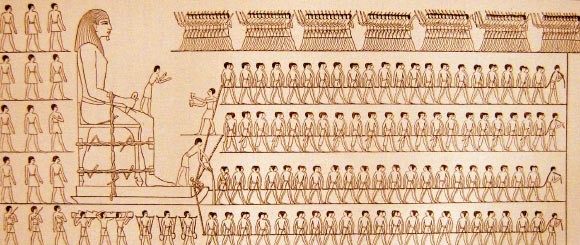Transporting the Stones:
In the process of building
the Great Pyramid the first hurdle which would have had to
have been overcome is moving the massive blocks of stone
from where they were quarried to their final resting
place. For numerous reasons this would have not been an
easy task:
- The average limestone
block used in construction weighed between 2.5 and
6 tons and some weighed considerably more 2.
- The Egyptians did have access to modern technologies which we take for granted today, like wheels!
When it comes to hauling large objects the main
difficulty would have been overcoming the friction
between the block and the ground. Kinetic friction is a
force which acts upon an object opposite the direction
of motion and is given by the equation:
( m = mass g = acceleration due to
gravity µ = frictional
coefficient)
The frictional coefficient is a constant which depends
on the surface which the blocks would have been dragged
across, in this case sand. As we can see from the
equation, for blocks with a large mass the force of
friction would have been immense and difficult to
overcome for the Egyptians. But, luckily they had
a few tricks up their sleeves.

By placing the quarried blocks on sleds and lubricating the sand in front of them with water the workers could have greatly reduced the frictional coefficient (µ) between the wooden sled and the sand. In fact, experiments conducted by a team of researchers (Fall et al.) has shown that lubricating with water in this manner could reduce the frictional coefficient from around 0.54 to 0.30 3. Using this technique, the Egyptians could have moved these massive blocks from where they were quarried to the pyramid with far greater ease.